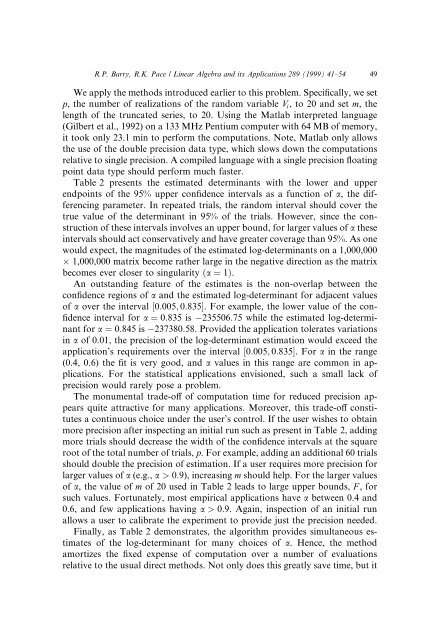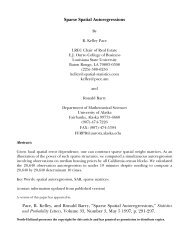"Monte Carlo Estimates of the Log Determinant of ... - Spatial Statistics
"Monte Carlo Estimates of the Log Determinant of ... - Spatial Statistics
"Monte Carlo Estimates of the Log Determinant of ... - Spatial Statistics
Create successful ePaper yourself
Turn your PDF publications into a flip-book with our unique Google optimized e-Paper software.
R.P. Barry, R.K. Pace / Linear Algebra and its Applications 289 (1999) 41±54 49<br />
We apply <strong>the</strong> methods introduced earlier to this problem. Speci®cally, we set<br />
p, <strong>the</strong> number <strong>of</strong> realizations <strong>of</strong> <strong>the</strong> random variable V i , to 20 and set m, <strong>the</strong><br />
length <strong>of</strong> <strong>the</strong> truncated series, to 20. Using <strong>the</strong> Matlab interpreted language<br />
(Gilbert et al., 1992) on a 133 MHz Pentium computer with 64 MB <strong>of</strong> memory,<br />
it took only 23.1 min to perform <strong>the</strong> computations. Note, Matlab only allows<br />
<strong>the</strong> use <strong>of</strong> <strong>the</strong> double precision data type, which slows down <strong>the</strong> computations<br />
relative to single precision. A compiled language with a single precision ¯oating<br />
point data type should perform much faster.<br />
Table 2 presents <strong>the</strong> estimated determinants with <strong>the</strong> lower and upper<br />
endpoints <strong>of</strong> <strong>the</strong> 95% upper con®dence intervals as a function <strong>of</strong> a, <strong>the</strong> differencing<br />
parameter. In repeated trials, <strong>the</strong> random interval should cover <strong>the</strong><br />
true value <strong>of</strong> <strong>the</strong> determinant in 95% <strong>of</strong> <strong>the</strong> trials. However, since <strong>the</strong> construction<br />
<strong>of</strong> <strong>the</strong>se intervals involves an upper bound, for larger values <strong>of</strong> a <strong>the</strong>se<br />
intervals should act conservatively and have greater coverage than 95%. As one<br />
would expect, <strong>the</strong> magnitudes <strong>of</strong> <strong>the</strong> estimated log-determinants on a 1,000,000<br />
1,000,000 matrix become ra<strong>the</strong>r large in <strong>the</strong> negative direction as <strong>the</strong> matrix<br />
becomes ever closer to singularity …a ˆ 1†.<br />
An outstanding feature <strong>of</strong> <strong>the</strong> estimates is <strong>the</strong> non-overlap between <strong>the</strong><br />
con®dence regions <strong>of</strong> a and <strong>the</strong> estimated log-determinant for adjacent values<br />
<strong>of</strong> a over <strong>the</strong> interval ‰0:005; 0:835Š. For example, <strong>the</strong> lower value <strong>of</strong> <strong>the</strong> con-<br />
®dence interval for a ˆ 0:835 is 235506:75 while <strong>the</strong> estimated log-determinant<br />
for a ˆ 0:845 is 237380:58. Provided <strong>the</strong> application tolerates variations<br />
in a <strong>of</strong> 0:01, <strong>the</strong> precision <strong>of</strong> <strong>the</strong> log-determinant estimation would exceed <strong>the</strong><br />
application's requirements over <strong>the</strong> interval ‰0:005; 0:835Š. For a in <strong>the</strong> range<br />
(0.4, 0.6) <strong>the</strong> ®t is very good, and a values in this range are common in applications.<br />
For <strong>the</strong> statistical applications envisioned, such a small lack <strong>of</strong><br />
precision would rarely pose a problem.<br />
The monumental trade-o€ <strong>of</strong> computation time for reduced precision appears<br />
quite attractive for many applications. Moreover, this trade-o€ constitutes<br />
a continuous choice under <strong>the</strong> user's control. If <strong>the</strong> user wishes to obtain<br />
more precision after inspecting an initial run such as present in Table 2, adding<br />
more trials should decrease <strong>the</strong> width <strong>of</strong> <strong>the</strong> con®dence intervals at <strong>the</strong> square<br />
root <strong>of</strong> <strong>the</strong> total number <strong>of</strong> trials, p. For example, adding an additional 60 trials<br />
should double <strong>the</strong> precision <strong>of</strong> estimation. If a user requires more precision for<br />
larger values <strong>of</strong> a (e.g., a > 0:9), increasing m should help. For <strong>the</strong> larger values<br />
<strong>of</strong> a, <strong>the</strong> value <strong>of</strong> m <strong>of</strong> 20 used in Table 2 leads to large upper bounds, F , for<br />
such values. Fortunately, most empirical applications have a between 0.4 and<br />
0.6, and few applications having a > 0:9. Again, inspection <strong>of</strong> an initial run<br />
allows a user to calibrate <strong>the</strong> experiment to provide just <strong>the</strong> precision needed.<br />
Finally, as Table 2 demonstrates, <strong>the</strong> algorithm provides simultaneous estimates<br />
<strong>of</strong> <strong>the</strong> log-determinant for many choices <strong>of</strong> a. Hence, <strong>the</strong> method<br />
amortizes <strong>the</strong> ®xed expense <strong>of</strong> computation over a number <strong>of</strong> evaluations<br />
relative to <strong>the</strong> usual direct methods. Not only does this greatly save time, but it



